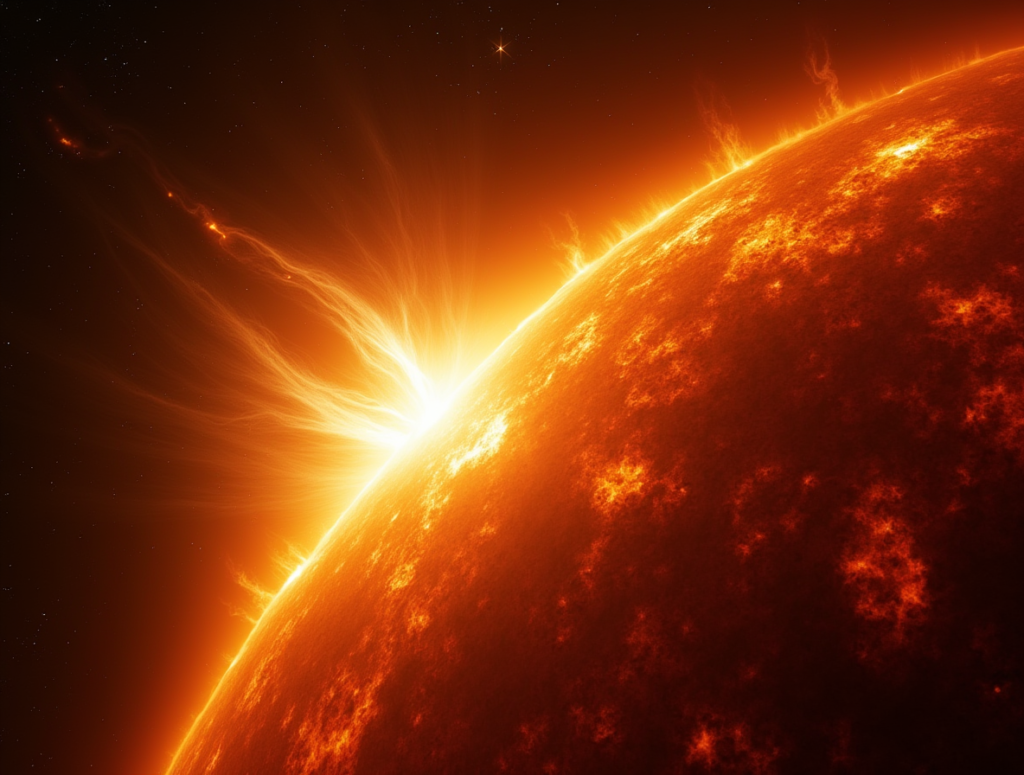2025 Apocalypse? The Threat of a Solar Flare
Solar cycle 25 is going to be at its peak in the year 2025 and scientists are constantly observing solar activities, Concerning about the 2025 Apocalypse. including solar flares and coronal mass ejections (CMEs) that seem to be increasing in frequency and intensity. Effects from these solar activities may interfere with the technology infrastructures on Earth and will include disruption of satellites, power grids, and communication lines.
Solar observations of recent origin have noted some extremely strong solar flares; among them was the X3.3 flare on October 23, 2024, the biggest so far of Solar Cycle 25.
Understanding solar flares

To put it simple solar flares are the high intensity energy bursts coming out from the sun’s surface. When the magnetic field coming out of the sun got twisted and suddenly regain its original shape its release good amount of energy so that’s why it is also called magnetic reconnection.
Solar flares are of various types, differentiate based on their brightness level on the X-ray scale.
- X-Class: The most powerful, capable of causing widespread radio blackouts and long-lasting radiation storms.
- M-Class: Medium-sized, leading to brief radio blackouts that affect Earth’s polar regions.
- C-Class: Small, with minimal noticeable impact on Earth.
Formations of Solar Flares
Solar flares are formed when magnetic fields in the outer atmosphere of the Sun, known as the corona, become highly twisted and tangled due to the movement of plasma. This magnetic energy is stored and, when it exceeds a critical threshold, it is released in the form of a flare. The energy is released through a process called magnetic reconnection, where opposing magnetic fields rapidly reconnect and reorganize, releasing massive amounts of energy.
Prediction and Observation of Solar Flare
Although the scientists cannot predict the solar flares, they do use observations of the Sun and models to predict flare activity. Space-based telescopes such as NASA’s Solar Dynamics Observatory (SDO) and the Solar and Heliospheric Observatory (SOHO), along with ground-based observations, help track solar activity. Studying sunspots, magnetic fields, and other phenomena on the Sun, researchers can make predictions about when and where flares are likely to occur. However, the exact timing and intensity of solar flares are still very hard to predict.
Solar flare activity cycle
Overview of the 11-Year Solar Cycle
The Schwabe cycle, or solar cycle, is an approximately 11-year period that describes the fluctuations in solar activity, including sunspots, solar flares, and coronal mass ejections (CMEs). This cycle plays a key role in influencing space weather, which in turn affects technological systems on Earth. The cycle progresses through two primary phases: the solar minimum and the solar maximum.
- During solar minimum, the Sun experiences very low activity, with few sunspots and minimal solar flare occurrences. This phase is marked by a less turbulent magnetic field, resulting in generally stable space weather conditions.
- In contrast, solar maximum is characterized by heightened solar activity, with an increased number of sunspots and stronger solar flares. During this period, the Sun’s magnetic field undergoes significant changes, and space weather events are more frequent and intense.
Solar Cycle 25, which began in December 2019, is expected to reach its peak between 2024 and 2025. Early predictions suggested a maximum with about 115 sunspots, but recent observations indicate even higher activity. By August 2024, sunspot activity had averaged 215.5 daily sunspots, the highest in over two decades, signaling an earlier-than-expected solar maximum.
This increased solar activity is expected to lead to more frequent solar flares and CMEs, which may interfere with satellite communications, GPS systems, and even power grids on Earth. As Solar Cycle 25 continues to evolve, understanding its dynamics is essential for preparing for these potential space weather impacts, which could disrupt technological systems globally.
History of Solar flare and their Impact
The Carrington Event of 1859
The Carrington Event is a powerful solar storm that was seen in the early days of September 1859. This event was named after British astronomer Richard Carrington, who observed the phenomenon. The event is the largest geomagnetic storm ever recorded on record. Carrington and his fellow astronomer, Richard Hodgson, simultaneously observed a very large solar flare associated with a large sunspot group on September 1, 1859. About 17 hours later, Earth witnessed an extraordinary auroral show, and the auroras reached as far south as the Caribbean. All over the world, telegraph systems were knocked off, with operators receiving electric shocks and some pylons for the telegraphs even catching fires. If it were to happen now, this might have seriously impacted modern electrical and communication systems around the globe.
The 1989 Quebec Blackout
On March 13, 1989, a powerful geomagnetic storm caused a massive blackout in Quebec, Canada. The storm was triggered by a coronal mass ejection (CME) from the Sun, which induced geomagnetic currents that affected Earth’s magnetic field. The Hydro-Québec power grid was particularly vulnerable, leading to a 9-hour outage that affected millions of residents. The event highlighted the potential vulnerabilities of modern power grids to space weather phenomena.
Other Notable Solar Flares in History
Not only did it black out the Quebec region but also caused widespread effects on power systems owing to the March 1989 geomagnetic storm, which blacked out the Hydro-Québec system.
July 2012 Solar Storm: A huge solar storm in July 2012 narrowly missed Earth, with a CME traveling at 4,000 kilometers per second. Had it hit Earth, it could have caused significant disruptions to satellite communications and power grids.
Predictions about the 2025 Apocalypse

The current 11-year cycle of solar activity is Solar Cycle 25, which began on December 2019. The predictions for this cycle have changed with the flow of new data available.
Predictions
Initial Predictions The early prognoses suggest that the solar maximum or the peak solar activity would be around July 2025 at a sunspot number of approximately 115. NATIONAL WEATHER SERVICE
Revised Predictions: Later reanalyses were found to suggest a stronger peak that occurs sooner. NOAA predicts the solar maximum to be from January to October 2024 with sunspot numbers that range from 137 to 173.
SWPC
Actual Observations:
Solar Activity: Since December 2024, the solar activity has been strong. For instance, on 3rd October, 2024, the Sun released a solar flare X9.0, which is the biggest till date in Solar Cycle 25.
SVS NASA
Geomagnetic Events: In May 2024, a major solar storm led to the lighting of lights around quite low latitudes. This again indicated increased solar activities.
WIKIPEDIA
Conclusion:
The actual solar activity observed in 2024 already follows the revisions, which indeed show a steeper and stronger peak in Solar Cycle 25 than initially estimated. This thus underlines dynamic solar behavior that requires continuous follow-up to achieve better understanding of and prediction regarding space weather.
Northern Lights Showing Up Early Next Year 2025
Recently asked Questions
1. What is a solar flare?
A solar flare is a sudden, intense burst of energy on the Sun’s surface, which releases a large amount of radiation into space. These flares can impact space weather, disrupting satellite communications, GPS systems, and even power grids on Earth.
2. What is Solar Cycle 25?
Solar Cycle 25 refers to the current 11-year cycle of solar activity that started in December 2019. It includes phases of varying solar activity, from solar minimum (few sunspots) to solar maximum (many sunspots and intense solar flares). The peak of this cycle is expected to occur between 2024 and 2025.
3. When is the solar maximum expected in Solar Cycle 25?
The solar maximum of Solar Cycle 25 is predicted to occur between 2024 and 2025. This is when solar activity, including sunspots and solar flares, will be at its highest.
4. How do solar flares affect Earth?
Solar flares can cause disruptions in satellite communications, GPS systems, and even power grids. The increased solar radiation can interfere with the normal operation of these systems, leading to potential outages or malfunctions.
5. Can solar flares cause an apocalypse in 2025?
While solar flares and other solar activities, like coronal mass ejections (CMEs), can impact technology on Earth, the likelihood of an apocalypse caused by solar events is extremely low. However, the heightened activity in Solar Cycle 25 could cause significant disruptions, which is why monitoring solar weather is important.
